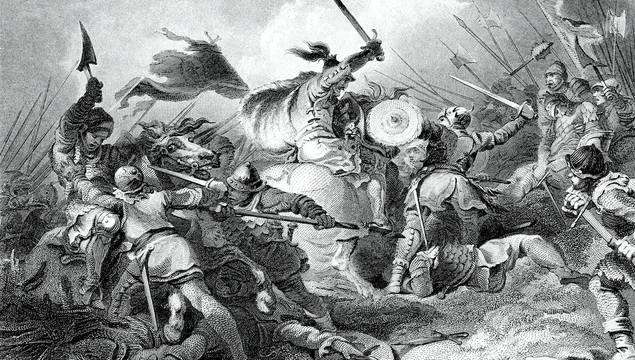
Engraving From 1882 Of The Battle Of Hastings Between The French And English Armies Of 1066.Getty
You know that The Battle of Hastings was a bloody fight between the Normans and the Saxons, but how exactly were the Normans armed? Here's everything you need to know about their armor and weaponry.
The army of William of Normandy that landed at Pevensey on 28th September 1066 was a well-equipped fighting force composed of hardened and well-trained soldiers. But what was it like to be one of those soldiers? How did it feel to fight as the Normans and their allies?
To answer those questions it is necessary to know what weapons the Normans and their allies employed as well as what protective clothing they wore.
Some form of protective clothing was worn by most of the Norman horsemen, but in general, the foot soldier was less well armored and many infantrymen wore no armor at all. The Bayeux Tapestry, which was completed sometime in the 1080s and is by far the best pictorial source of information about the arms and armor of the Normans, contains a total of 201 armed men of whom 79 are wearing some armor.
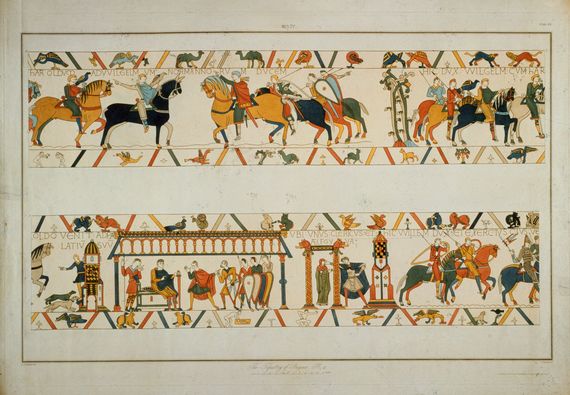
The hauberk & coif
The usual form of body armor used by the Norman horseman was a knee-length mail shirt called a hauberk that had three-quarter-length sleeves and was split from hem to fork to facilitate riding. Although usually constructed of mail the hauberk does occasionally seem to have been made of overlapping scales of some stiff material such as cow horn. But such scale armor never seriously challenged the supremacy of mail formed of interlinked, riveted rings that could be made very strong and, because of its pliability, still gave the soldier complete freedom of movement.
To complement the mail shirt some warriors illustrated on the Tapestry have leg and arm defenses also of mail, and such defenses seem to have become increasingly popular. In some case, the hauberk is shown apparently extending over the head as a hood or coif, although sometimes the coif appears to be separate from the hauberk. It is now impossible to tell whether this mail armor of the Normans had any lining to make it more comfortable to wear, but it was certainly worn over some form of clothing and not next to the skin, as is suggested in one badly restored portion of the tapestry.
How practicalities of wearing armor
The greatest drawback of mail armor seems to have been its weight. To bear a long mail hauberk hanging as dead weight from the shoulders for very long would have sapped the strength of even a man trained from childhood to wear armor. It would appear that the Normans were well aware of this and that they wore their armor only when absolutely necessary. The Chanson de Roland (written at the end of the 11th century by an Anglo-Norman) contains much accurate information about the armor and weapons of the Normans and how they were used. In this work, neither armor nor weapons are worn while fighting men are on the march unless there is some danger of an ambush.
It would appear that the full equipment of war was only put on just before a battle and often when in sight of the enemy. Corroboration of this can be found in the works of Norman historians. For instance, the Chronicle of Battel Abbey states that Duke William halted the advance of his army from Hastings at Hechelande, less than three miles from the waiting Saxon forces, so that he might put on his armor. One can assume that most of his army dressed for battle at the same time. The Abbey Chronicle was not written until nearly 100 years after the battle, so it may not be a true account of events in 1066, but it must accurately have reflected normal 12th-century military practice, and neither arms nor armor can have changed much in the intervening years.
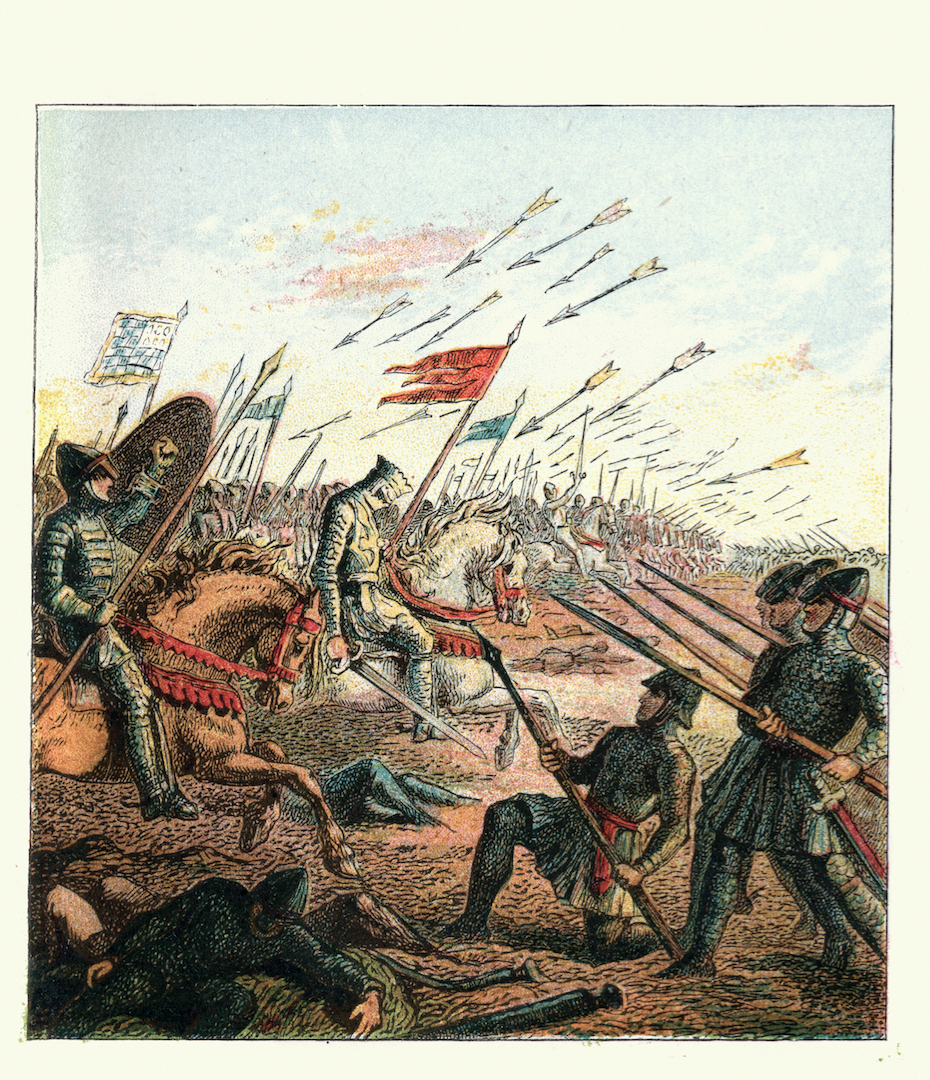
Vintage engraving of the Battle of Hastings was fought on 14 October 1066 between the Norman-French army of Duke William II of Normandy and an English army under the Anglo-Saxon King Harold Godwinson, beginning the Norman conquest of England.
That armor was sometimes too debilitating and weighty for the soldiers of the time is shown by an anecdote in the chronicles of William of Poitiers who was writing between 1071 and 1076. He recounts that when William landed at Pevensey on an inhospitable and unfriendly shore he reconnoitered the surrounding country with about 25 soldiers, one of who became so exhausted that, despite the possibility of attack, the Duke carried his mail hauberk for him on their return.
The introduction of the shield
As an additional protection for his head, the Norman soldier wore a steel helm, usually of conical form. Most had wide nasals to protect the nose. These helms were apparently made either in one piece or in several segments riveted together and sometimes, it seems, attached to a supporting framework of steel bands. The Chanson de Roland tells us that the helms of kings and princes were frequently set with jewels, normally above the nasal, and there is other evidence to support this. The helm preserved in Prague Cathedral as that of St Wenceslas has a one-piece skull with an applied nasal decorated with a scene of the crucifixion, and a stone capital in the Musee Granet at Aix-en-Provence appears to show helms with jeweled browbands. These helms were held firmly on the head by means of laces tied beneath the chin.
Apart from the helm and mail shirt, the third piece of armor carried by the Norman knight was a shield that was worn to cover the left side of the body and protect the bridle hand. Most popular was the kite-shaped shield, a type introduced in the late 10th century, which offered greater protection to the soldiers than the older round shield. However, the round shield never went completely out of favor and is often shown being used by cavalry in 11th and 12th-century illustrations. Whatever the shape of the shield, most were made of wood covered with leather and often painted with decorative patterns and devices.
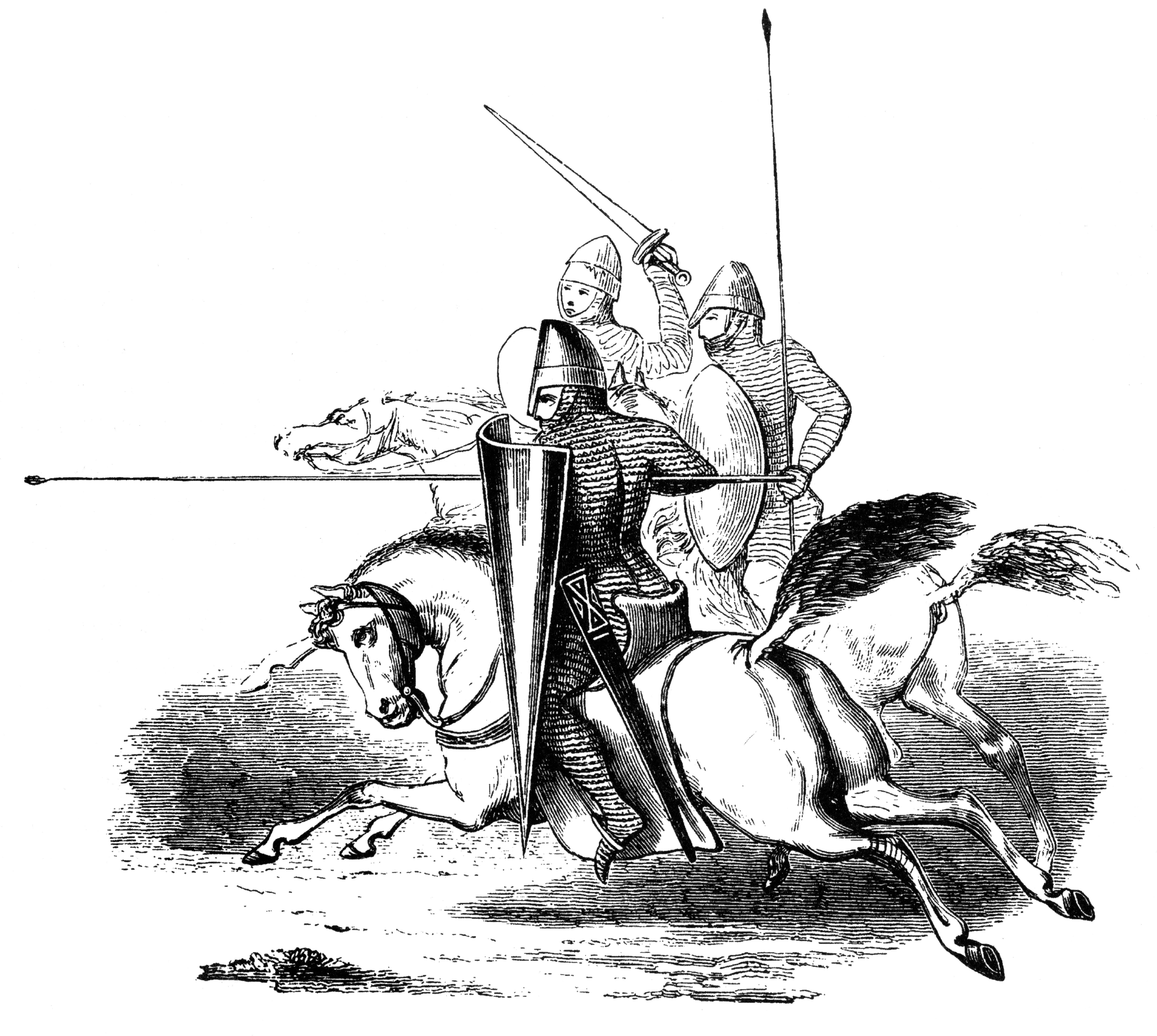
French Knights
The basic weapon of the Norman cavalry and infantry was a spear with a leaf-shaped head of iron and a wooden haft, usually of ash. The only difference visible in contemporary illustrations between infantry and cavalry spears is that infantry spears sometimes appear thicker in the haft. Both are often shown with a horizontal crossbar beneath the head, intended to prevent excessive penetration. This feature is also found on earlier Saxon and Carolingian weapons. Massed infantry could probably form a hedge of spears as protection against cavalry as they did later in the 12th century, the spear points angled forward, the haft ends resting on the ground. But this is not the usual way in which spears were used. In contemporary illustrations, they are more frequently shown held above the head and wielded in a downward stabbing movement, the same technique being used against both cavalry and infantry. Using this technique the spear could be thrown when required and this would explain why in most manuscript illustrations of the 11th and 12th centuries spears would appear to be of lightweight construction.
The cavalry spear, known to use as the lance, was used in much the same way, either at arm's length, usually overarm, or couched under the arm to give greater rigidity to the weapon and force to the attack. When couched the spear would be crossed over the horse's neck right to left where it could be balanced, a technique that had the added advantage that opponents approached each other left side to left side and it was on the left side that they had the added protection of their shield. But even this added protection was not always sufficient.
Cavalry, as well as infantry, could throw the spear when required, and the Bayeux Tapestry shows not only some of the Norman cavalry throwing spears at the Saxon forces but also an ammunition wagon arriving with replacement spears.
The sword & the differences with the aristocracy
But if the lance and spear were the most common of weapons, they do not appear to have been the most common among the Norman aristocracy. The majority of the infantry were usually armed only with a spear; however, most cavalrymen also carried a sword. An almost religious mystique surrounded this weapon, heightened no doubt by the pseudo-religious significance of the cross shape of the hilt. Veneration of the sword runs through both Saxon and Viking literature and is one of the most enduring legacies of the Dark Ages.
The reason is probably that, unlike the lance or spear that was easily broken and usually discarded during battle, the sword was a valuable possession, a trusty defender often handed down from generation to generation. Many times swords were given personal names and sometimes had relics concealed in the pommel and religious inscriptions on the blade to give the owner the protection of the Almighty, His angels, or one of His saints.
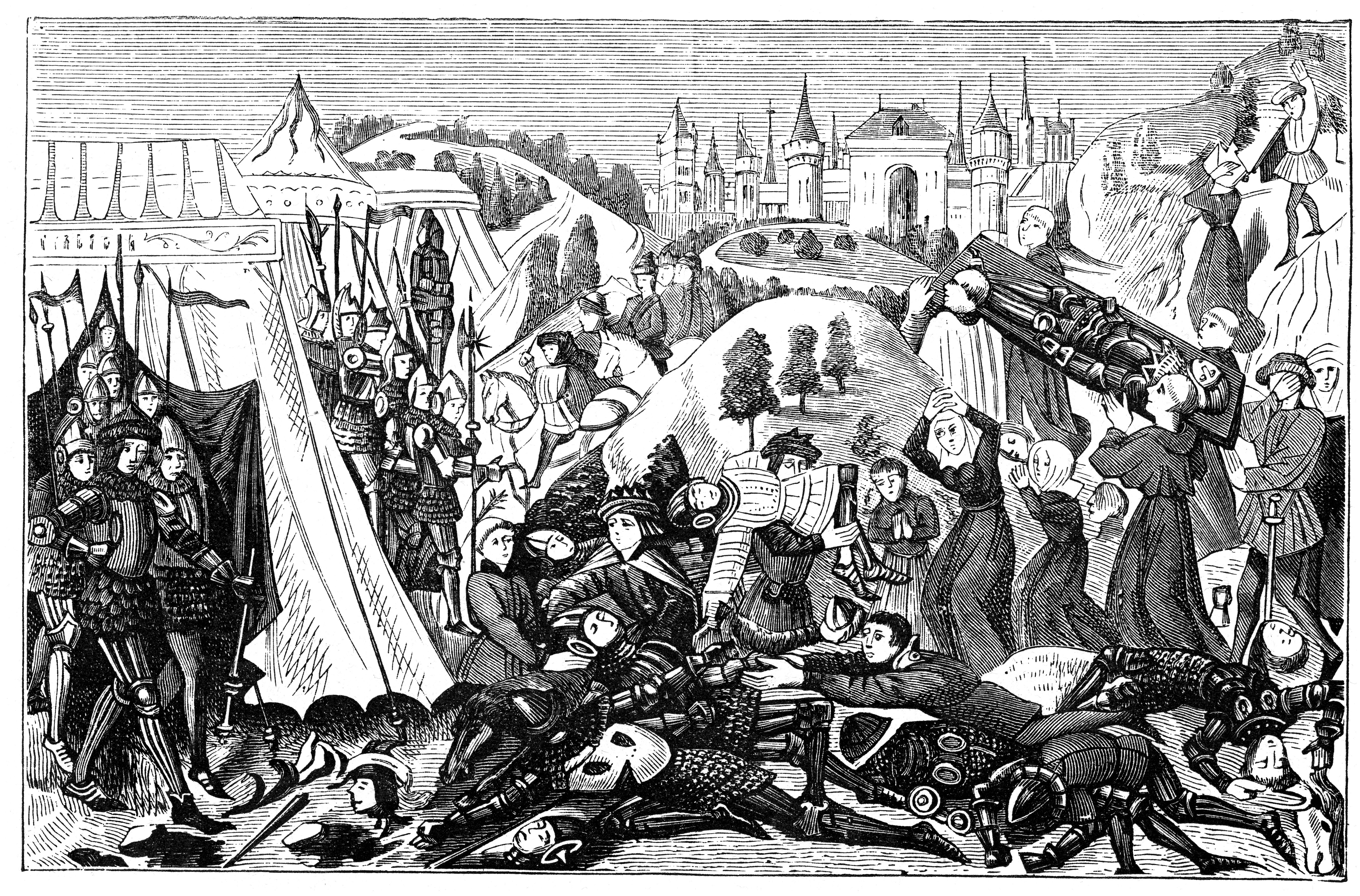
'Vintage engraving from 1876 of showing the aftermath of the Battle of Hastings in 1066, with people removing bodies from the battlefield'
The detailed descriptions of cavalry combat given in the Chanson de Roland show quite clearly that the sword was not used until the spear was broken or lost. Only then would the sword be drawn from its wooden sheath. The favorite sword stroke of the Norman knight was the downward cutting blow delivered to the top of the head. Well aimed, it could cut through both helm, mail coif, and skull. The hero Roland is even described as killing rider and horse with one blow, cleaving through the head, trunk, saddle, and horse, and, though obviously exaggerated, it may not be so far from the truth. Certainly, literature and illustrations show that the sword was conceived almost entirely as a cutting weapon, the thrusting stroke being used only for administering the coup de grace.
The typical sword of a Norman soldier was a very simple and serviceable weapon with a double-edged, straight blade just over a yard long tapering to a point. A rounded hollow or 'fuller' running down the blade to near the point enabled the blade to be made lighter and thus easier to wield without in any way impairing its strength. The hand was protected by a simple metal cross-guard. Although no grips survive they were almost certainly of wood and were probably bound with interlaced thongs of cord or leather. The pommel was usually of domed form although lobate and disc-shaped pommels are found. Though sometimes decorative, the pommel's real purpose was to act as a counterweight to the blade, thus making the sword easier to wield.
Not forgetting the axe
The spear and sword were not the only bladed hand-weapons used by the Normans. The axe, that terrible weapon of the Vikings, was still used by their Norman descendants though it seems to have been more popular among the Saxons. If the Bayeux Tapestry is to be believed it could inflict more dire wounds than any other weapon on the battlefield.
Although spears could be thrown when necessary, the main projectile weapon of the Norman army was the bow and arrow, used for long-range fighting and to keep the enemy from engaging in hand-to-hand combat. The Bayeux Tapestry shows Duke William's archer infantry, their quivers either slung over their shoulders or hung from the waist, playing an important part in the battle. They appear to be shooting bows somewhat shorter than a six-foot longbow, but there is no evidence to prove whether the Norman bow was short or long for none survives. They appear to be drawing their bows not to the ear but to the body only.
The archers were a very important part of Duke William's army and played perhaps the most decisive part in the battle. Certainly, the bow had an enduring place in the Anglo-Norman army. After Hastings the bow seems to have been used almost exclusively as an infantry weapon but the Bayeux Tapestry attests to the fact that it could occasionally be used by mounted troops for pursuit of a fleeing enemy.
The crossbow
Perhaps the most neglected weapon of the Norman period is the crossbow, which was almost certainly known to and used by the Normans well before 1066. Indeed, two of the 11th-century descriptions of the Battle of Hastings state that there were many crossbowmen in Duke William's army in 1066 and this arm formed an important part of the Norman armies that assembled for the First Crusade from 1098 onwards. By the beginning of the 12th century, the crossbow was undoubtedly the most important projectile weapon not only of the Norman army but of almost every army in Europe. The crossbow used by the Normans probably had a wooden stock incorporating some form of rudimentary lock and release mechanism of the revolving nut type that was to become so popular later. But however constructed, the Norman crossbow, like the Norman bow, was a formidable weapon quite capable of piercing the main defenses of the best-protected warriors.
Fighting in the 11th century was a hard, uncertain, and very bloody business. Men skilled and practiced in the use of the weapons described were truly formidable opponents, and however well protected an armored knight might appear, his armor was not proof against such weapons in skilled hands. A well-trained blow would usually main or kill, and often instant death was preferable to a lingering death from a festering wound.
Read more
* Originally published in 2006.





Comments